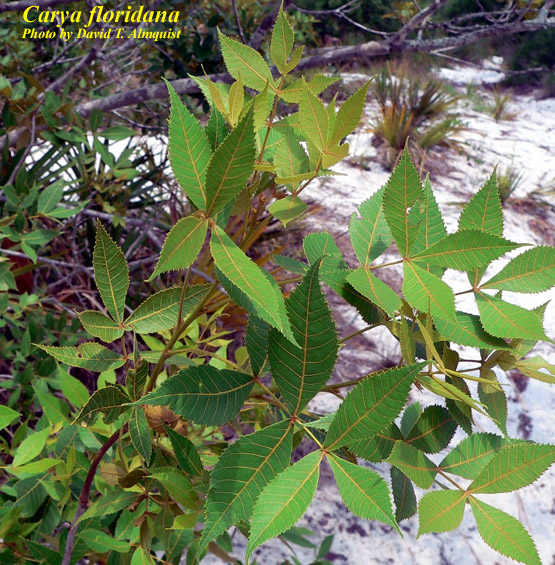Difference between revisions of "Carya floridana"
Krobertson (talk | contribs) (→Conservation and management) |
(→Taxonomic notes) |
||
| Line 20: | Line 20: | ||
==Taxonomic notes== | ==Taxonomic notes== | ||
Synonym: ''Hicoria floridana'' (Sargent) Sudworth | Synonym: ''Hicoria floridana'' (Sargent) Sudworth | ||
| + | |||
| + | Varieties: none | ||
| + | |||
==Description== | ==Description== | ||
<!-- Basic life history facts such as annual/perrenial, monoecious/dioecious, root morphology, seed type, etc. --> | <!-- Basic life history facts such as annual/perrenial, monoecious/dioecious, root morphology, seed type, etc. --> | ||
Revision as of 13:24, 26 June 2018
| Carya floridana | |
|---|---|

| |
| Photo by David T. Almquist, Atlas of Florida Vascular Plants | |
| Scientific classification | |
| Kingdom: | Plantae |
| Division: | Magnoliophyta - Flowering plants |
| Class: | Magnoliopsida - Dicotyledons |
| Order: | Juglandales |
| Family: | Juglandaceae |
| Genus: | Carya |
| Species: | C. floridana |
| Binomial name | |
| Carya floridana Sarg. | |

| |
| Natural range of Carya floridana from USDA NRCS Plants Database. | |
Common name: Scrub hickory
Contents
Taxonomic notes
Synonym: Hicoria floridana (Sargent) Sudworth
Varieties: none
Description
A description of Carya floridana is provided in The Flora of North America.
C. floridana is a long-lived perennial woody species, that can grow up to 20 meters high.[1] [2] It can be identified from other Carya species by having rust-colored scales on the buds and lower leaf surfaces.[3]
Distribution
Carya floridana is endemic to central Florida and is the most abundant hardwood in the southern Lake Wales Ridge.[4][5] The range is influenced by edaphic and climatic conditions.[4]
Ecology
Habitat
In the Coastal Plain in Florida, C. floridana has been found in sand pine woods with Lyonia ferruginea; sand pine-oak scrubs; sand ridge scrubs; hardwood hammocks; scrub oak-wiregrass ridges; and scrub barrens.[6] It is an aggressive invader of open xeric woodlands; however, nutrient availability and water limit seedling survival.[4][7] Soil types include entisols, Astatula-Paola-Tavares of the series Quartzipsamments.[4] Associated species include Persea, Quercus laevis, Q. myrtifolia, Q. geminata, Q. chapmanii, Sabal etonia, Serenoa repens, Polygonella, Ceranthera, Ilex cumulicola, Pinus elliottii var. densa, and Garberia.[6]
Phenology
Flowers are monecious, flowering January through April and fruiting June through October.[2][6]
Seed dispersal
Seeds are dispersed by wind.[2]
Seed bank and germination
C. floridana does not have the seed dormancy trait that can be found in commercial hickories of the eastern deciduous forest.[4] Hickories have one of the longest taproots observed among the eastern hardwoods, this allows them to resprout repeatedly following heavy disturbances.[4] Adequate moisture is needed for seed germination.[4]
Fire ecology
C. floridana is an understory plant found in sandhills along the Lake Wales Ridge. In order to maintain an open southern ridge sandhill, frequent low intensity fires are needed. Long-term fire suppression in sandhill communities results in Quercus and Carya floridana dominated xeric hammocks.[8]
Pollination
The following Hymenoptera families and species were observed visiting flowers of Carya floridana at Archbold Biological Station:[9]
Apidae: Apis mellifera
Use by animals
Fruits are eaten by rodents, black bears, foxes and raccoons and provide a high concentration of energy, protein, fat, fiber, nitrogen, phosphorous, iron, copper, and zinc. They are important to squirrel diets during the autumn and spring months.[10]
Diseases and parasites
Mistletoe (Phoradendron serotinum) is a parasite that attacks Carya species.[11]
Conservation and management
In areas of fire suppression and well drained, nutrient poor soils along the Lake Wales Ridge, C. floridana will become the dominant overstory species.[4][5]
Cultivation and restoration
Photo Gallery
References and notes
- ↑ [Florida Native Plant Society]Accessed: December 4, 2015
- ↑ 2.0 2.1 2.2 [Plants for a Future] Accessed: December 4, 2015
- ↑ [[1]] Accessed: December 4, 2015
- ↑ 4.0 4.1 4.2 4.3 4.4 4.5 4.6 4.7 McCarthy, Brian C., and Donald R. Bailey. “Seed Germination and Seedling Establishment of Carya Floridana (sarg.) Small (juglandaceae)”. Bulletin of the Torrey Botanical Club 119.4 (1992): 384–391
- ↑ 5.0 5.1 Myers, Ronald L., and Deborah L. White. “Landscape History and Changes in Sandhill Vegetation in North-central and South-central Florida”. Bulletin of the Torrey Botanical Club 114.1 (1987): 21–32.
- ↑ 6.0 6.1 6.2 Florida State University Robert K. Godfrey Herbarium database. URL: http://herbarium.bio.fsu.edu. Last accessed: October 2015. Collectors: L.J. Brass, D. Burch, Brevard, A.F. Clewell, R.F. Christensen, Angus Gholson, R.K. Godfrey, R. Kral, O. Lakela, Robert J. Lemaire, S.W. Leonard, Walter S. Judd, K.M. Meyer, John B. Nelson, R.W. Simons, A. Townesmith, D.B. Ward, R.H. Wnek. States and Counties: Florida: Brevard, Highlands, Indian River, Lake, Marion, Martin, Palm Beach. Compiled by Tall Timbers Research Station and Land Conservancy.
- ↑ Myers, R.L. 1990. Scrub and high pine, pp. 150-193. In R.L. Myers and J.J. Ewel, Ecosystems of Florida. Univ. of Central Florida Press, Orlando.
- ↑ Menges, E. S. et al.. “Twenty Years of Vegetation Change in Five Long-unburned Florida Plant Communities”. Journal of Vegetation Science 4.3 (1993): 375–386.
- ↑ Deyrup, M.A. 2015. Database of observations of Hymenoptera visitations to flowers of plants on Archbold Biological Station, Florida, USA.
- ↑ Abrahamson, Warren G., and Christy R. Abrahamson. “Nutritional Quality of Animal Dispersed Fruits in Florida Sandridge Habitats”. Bulletin of the Torrey Botanical Club 116.3 (1989): 215–228.
- ↑ [Fresh From Florida]Accessed: December 4, 2015